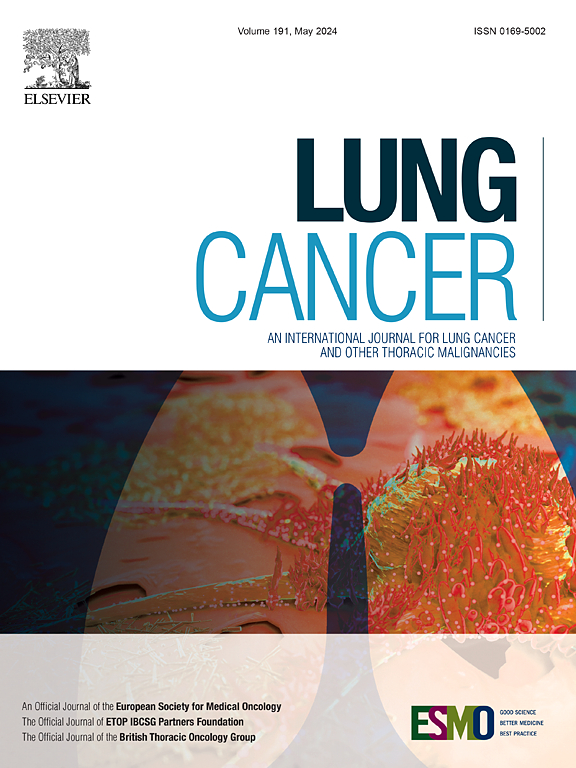amivantamab在EGFR外显子20突变的非小细胞肺癌中的实际疗效和安全性:Amexon 20 GFPC研究
IF 4.4
2区 医学
Q1 ONCOLOGY
引用次数: 0
摘要
背景:Amivantamab是一种双特异性抗EGFR- met抗体,被批准用于治疗含有EGFR外显子20插入(EGFR-外显子20ins)的非小细胞肺癌(nsclc)。方法:我们在法国早期准入项目(2021年3月9日- 2022年4月30日)中,对连续接受≥1剂量阿米万他抗治疗的EGFR-exon20ins非小细胞肺癌患者进行了回顾性、多中心分析。主要终点是真实世界无进展生存期(rwPFS)。次要终点包括治疗时间、总生存期(OS)、脑转移(BMs)患者的预后和安全性。结果:纳入39例患者(中位年龄:60岁,64.1%为女性,54%为不吸烟者,33.3% ECOG- ps≥2;基线脑转移率为66.7%)。阿米万他单作为二线治疗的占30%,作为三线或之后治疗的占70%。患者接受的中位剂量为10剂(范围:1-47),中位[95% CI]为3.4[1.8-6.3]个月。在37例可评估的患者中,分别有35%[17% - 49%]和62%[44% - 76%]的患者达到部分缓解和疾病控制;中位缓解持续时间为5.8[2.3-11.9]个月。在BM患者中,23%的患者出现部分缓解,69%的患者出现疾病控制。中位随访11.3[8-16.7]个月后,中位rwPFS和OS分别为3.5[2.6-5.8]和11.3[8-17.8]个月。脑转移患者预后分别为2.8[3.5-17.8]和8.7[3.5-17.8]个月,无脑转移患者预后分别为7.6[1.6-13.5]和16.2 [8.3-NR]个月。11例(28.2%)患者发生≥3级不良事件,主要是皮肤毒性(12.8%)和输液反应(5.1%),导致17.9%的患者减少剂量,10.3%的患者永久停药。在多因素分析中,ECOG-PS≥2是rwPFS和OS的唯一负面预后因素。结论:Amivantamab在egfr -exon20in - nsclc中显示出临床活性,包括BM患者,具有可管理的安全性。本文章由计算机程序翻译,如有差异,请以英文原文为准。
Real-world efficacy and safety of amivantamab in EGFR exon-20-mutant non-small cell lung cancer in a French early-access program: Amexon 20 GFPC study
Background
Amivantamab is a bispecific anti-EGFR–MET antibody approved to treat non-small cell lung cancers (NSCLCs) harbouring EGFR exon 20 insertions (EGFR-exon20ins).
Methods
We conducted a retrospective, multicentre analysis of consecutive patients with EGFR-exon20ins NSCLC treated with ≥ 1 dose of amivantamab in a French early-access programme (09/03/2021–04/30/2022). The primary endpoint was real-world progression-free survival (rwPFS). Secondary endpoints included treatment duration, overall survival (OS), outcomes in patients with brain metastases (BMs), and safety.
Results
Thirty-nine patients were included (median age: 60 years; 64.1 % female, 54 % never-smokers, 33.3 % with ECOG performance status (ECOG-PS) ≥ 2; 66.7 % with BMs at baseline). Amivantamab was administered as second-line therapy in 30 % and third-line or later in 70 %. Patients received a median of 10 doses (range: 1–47) over a median [95 % CI] of 3.4 [1.8–6.3] months. Among 37 evaluable patients, partial responses and disease control were achieved in 35 % [17 %–49 %] and 62 % [44 %–76 %], respectively; median response duration was 5.8 [2.3–11.9] months. In patients with BM, partial response occurred in 23 % and disease control in 69 %. After a median follow-up of 11.3 [8–16.7] months, median rwPFS and OS were 3.5 [2.6–5.8] and 11.3 [8–17.8] months, respectively. Outcomes were 2.8 [3.5–17.8] and 8.7 [3.5–17.8] months in patients with BMs, and 7.6 [1.6–13.5] and 16.2 [8.3–NR] months in those without BMs, respectively. Grade ≥ 3 adverse events occurred in 11 patients (28.2 %), mainly skin toxicity (12.8 %) and infusion reactions (5.1 %), leading to dose reductions in 17.9 % and permanent discontinuation in 10.3 %. On multivariate analysis, ECOG-PS ≥ 2 was the only negative prognostic factor for both rwPFS and OS.
Conclusion
Amivantamab demonstrated clinical activity in EGFR-exon20ins-NSCLC, including in patients with BM, with a manageable safety profile.
求助全文
通过发布文献求助,成功后即可免费获取论文全文。
去求助
来源期刊

Lung Cancer
医学-呼吸系统
CiteScore
9.40
自引率
3.80%
发文量
407
审稿时长
25 days
期刊介绍:
Lung Cancer is an international publication covering the clinical, translational and basic science of malignancies of the lung and chest region.Original research articles, early reports, review articles, editorials and correspondence covering the prevention, epidemiology and etiology, basic biology, pathology, clinical assessment, surgery, chemotherapy, radiotherapy, combined treatment modalities, other treatment modalities and outcomes of lung cancer are welcome.
 求助内容:
求助内容: 应助结果提醒方式:
应助结果提醒方式:


